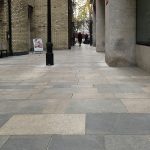Types of Stone Quarrying

Types of Stone Quarrying
Types of stone quarries are the focus of this passage. Stone quarrying is the multistage process by which rock is extracted from the ground and crushed to produce aggregate, which is then screened into the sizes required for immediate use, or for further processing, such as coating with bitumen to make bituminous macadam or asphalt.
Different Classifications
There are many classifications, such as hard rock, natural sand, natural sand and gravel, sandstone, marine/ocean, limestone. None of this categorizations are wrong. They are made according to different criterion. Stay with us. We will also suggest a four main types of stone quarrying in the upcoming text.
Types of Stone Quarrying
Stone is usually quarried in (1) Open pits or shelf quarries, (2) Underground mining, (3) Boulder quarries, and (4) Aggregate quarries.
Dimension Stone
Stone meant for use as cemetery stones, mausoleums, buildings, and bridges is considered dimension stone, which means the blocks of stone are cut to specific sizes or shapes. In the book, The Stone Industries by Oliver Bowles, Bowles describes dimension stone as follows: “Dimension Stone. The oldest use of stone and the one that has become increasingly important through the centuries is for building purposes. At first, rough walls were built of scattered boulders, but with increasing knowledge of the use of tools stone was quarried from solid ledges. Before the age of explosives and before steam and compressed air were utilized quarrying was slow and laborious….”
Dimension Stone Used for Other Purposes
“Dimension stone is used for other purposes than for building. In ancient times a pile of stones was raised as a memorial, and from this custom has developed the monument or headstone cut from suitable rock and carved with a fitting inscription. Stone blocks are also used for paving streets and roads and for the manufacture of curbing. In addition, stone has many special uses, such as for electrical switchboards and blackboards.”
Aggregate another Major Type of Stone
The other major type of stone is aggregate. Aggregate stone is produced by using a process which breaks or crushes the stone into various sizes for use as breakwaters, rip rap, road foundation, chicken grit, antacids, and many other uses. Many of the old dimension stone quarries are producing aggregate today rather than dimension stone.
Crushed Stone Described by Oliver Bowles
Oliver Bowles, in his book, The Stone Industries, published in 1939, described crushed stone as follows:
“Crushed Stone. Stone sledged by hand, usually by convict labor, was used in road construction, and this use increased rapidly. With the invention of cement and with mass production made possible through explosives, power crushers, and screens the broken-stone branch of the industry grew with phenomenal speed. In 1886 the output of crushed and broken stone was smaller than that of dimension stone, while in 1930 it was thirty times as great. Concrete aggregate, road stone, and ballast are the principal products.”
Open-pit Quarrying Described by Oliver Bowles
In Oliver Bowles book, The Stone Industries, published in 1939, he describes open-pit quarrying as follows: “Open-pit Quarrying. Most rock products of commerce are obtained from open quarries. Material suitable for use ordinarily is found at or near the surface of the earth, and the most economical method of working is to open up a face of the rock ledge. As rock is separated by blasting or other means, an opening is gradually enlarged and deepened, its size and shape depending greatly on the rock structures.
Underground Mining
When quarrying of rock first was begun as an industry, excavations were made in formations readily available at the surface of the earth. Through long years of continued operation the most available outcrops were gradually worked away, and quarries reached increasing depths. Many limestone beds which provide suitable stone dip at steep angles are of limited thickness. In following these beds down the dip at steep angles and are of limited thickness. In following these beds down the dip greatly increasing depths of overburden are encountered.
Boulder Quarrying
Another type of quarry is the boulder quarry from where blocks of stone are cut from boulders. This second photograph below shows where they quarried a boulder that was located near the Bell Marble Works quarry in Columbia, Tuolumne County.
Aggregate Quarrying
The majority of quarries operating today are aggregate quarries. Below are some photographs of aggregate quarries.
To learn more about us, click here.
Send your price quotes directly to our WhatsApp through this Link: https://wa.link/ord5k8
Sources
www.quarry.com.au/Public/Extractive-Industry/Types-of-Quarries/IQA/Extractive-Industry/Types-of-Quarries.aspx?hkey
www.northstonematerials.com/quarrying_process_and_quarry_products
- Back To Articles
- Aggregate Quarrying, armani grey marble, armany grey, Boulder Quarrying, crushed stone, Dimension Stone, dimension stone applications, dimension stone introduction, dimension stone uses, grey Armany, Open-pit Quarrying, Pietra Grey Marble, Pietra Grey Marble Tiles, Types of Stone Quarrying, Underground Mining
Article
Natural Stone Applications
- 22 December 2022
Iranian Stones Introduction According to Source and Quarry
- 21 December 2022
Technical Stone Introduction and Quarrying Procedures
- 21 December 2022
Categories
- blog757
- news1
- Specialized articles756













